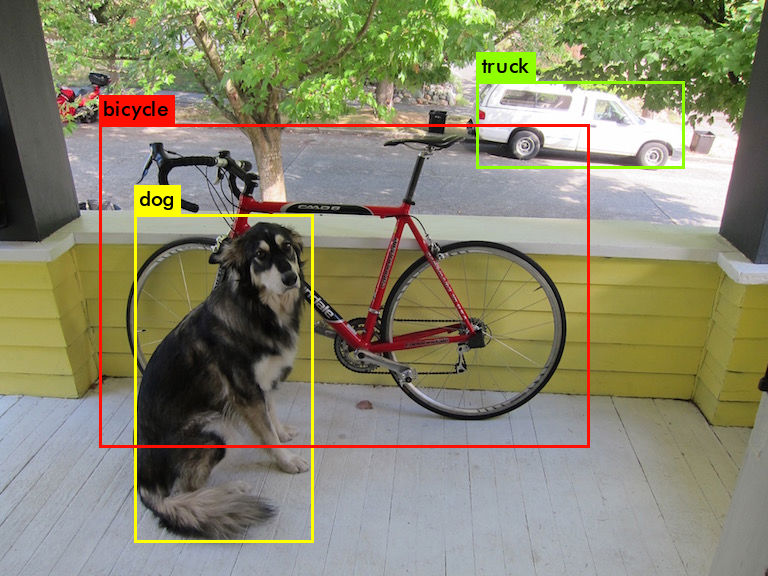

Despite the fact that using darknet is rather simple, there are still some points to focus on.
git clone https://github.com/pjreddie/darknet.git
cd darknet
make
It is possibile to run several jobs simultaenously if your system is multi-core/multi-processor. The easiest way to check the number of cores is nproc --all or cat /proc/cpuinfo, lscpu is also feasible.
make -j$(nproc)
Once compiled, the binary file is executed as below:
./darknet
Change the first line of Makefile into GPU=1, then change the content in brackets <...> listed below:
ifeq ($(GPU), 1)
COMMON+= -DGPU -I <...>
CFLAGS+= -DGPU
LDFLAGS+= -L<...> -lcuda -lcudart -lcublas -lcurand
endif
For instance, the default instll folder of CUDA on Arch Linux is /opt/cuda
ifeq ($(GPU), 1)
COMMON+= -DGPU -I /opt/cuda/include
CFLAGS+= -DGPU
LDFLAGS+= -L/opt/cuda/lib64 -lcuda -lcudart -lcublas -lcurand
endif
Then we need to look up the compute capability of our GPU here.
For instance, my GPU, NVIDIA GeForece MX130, is not listed in the form. ~~According to some articles, however, this card is exactly the same as GeForce 940MX, the compute capability of which, in that form, is 5.0.~~ According to wikipedia, the compute capability is exactly 6.1
Therefore, we need to change the architecture in Makefile for cuda compatibility.
In detail, change both the code to ten times of your compute capability, which is 61 for me.
# before
ARCH= -gencode arch=compute_30,code=sm_30 \
-gencode arch=compute_35,code=sm_35 \
-gencode arch=compute_50,code=[sm_50,compute_50] \
-gencode arch=compute_52,code=[sm_52,compute_52]
#-gencode arch=compute_20,code=[sm_20,sm_21] \ This one is deprecated?
# after
ARCH= -gencode arch=compute_61,code=sm_61 \
-gencode arch=compute_35,code=sm_35 \
-gencode arch=compute_50,code=[sm_50,compute_50] \
-gencode arch=compute_52,code=[sm_52,compute_52]
#-gencode arch=compute_20,code=[sm_20,sm_21] \ This one is deprecated?
After that we can compile it again using make -j$(nproc), and render darket with CUDA support.
Yolov3.weights downloaded, you can detect object in a rather good speed as followed:
./darknet detect cfg/yolov3.cfg yolov3.weights data/dog.jpg
By default darknet does not support OpenCV, which means you have to manually open the predicted picture generated in the folder.
Just open Makefile and enable it:
OPENCV=1
Notice that the dependency name of packageopencv in Arch Linux is opencv4. You can have a test by pkg-config --libs opencv4.
# before
ifeq ($(OPENCV), 1)
COMMON+= -DOPENCV
CFLAGS+= -DOPENCV
LDFLAGS+= `pkg-config --libs opencv` -lstdc++
COMMON+= `pkg-config --cflags opencv`
endif
# after
ifeq ($(OPENCV), 1)
COMMON+= -DOPENCV
CFLAGS+= -DOPENCV
LDFLAGS+= `pkg-config --libs opencv4` -lstdc++
COMMON+= `pkg-config --cflags opencv4`
endif
When we've happily modified the pkg-config and expected it to compile successfully, things happened: life is hard.
The compilation went error with
./src/image_opencv.cpp:12:1: error: ‘IplImage’ does not name a type
12 | IplImage *image_to_ipl(image im)
| ^~~~~~~~
compilation terminated due to -Wfatal-errors.
make: *** [Makefile:86: obj/image_opencv.o] Error 1
make: *** Waiting for unfinished jobs....
Some C APIs, which have been deprecated for a long time, were removed from the lateset OpenCV release. The solution is to remove references to the C APIs and use C++ API or to re-include the old C APIs from the OpenCV legacies.
Open src/image_opencv.cpp
#include "opencv2/imgproc/imgproc_c.h"
and change IplImage ipl = m in function mat_to_image(Mat m) to
IplImage ipl = cvIplImage(m)
also, in the function *void_video_stream(...)
// before
if(w) cap->set(CV_CAP_PROP_FRAME_WIDTH, w);
if(h) cap->set(CV_CAP_PROP_FRAME_HEIGHT, w);
if(fps) cap->set(CV_CAP_PROP_FPS, w);
// after
if(w) cap->set(CAP_PROP_FRAME_WIDTH, w);
if(h) cap->set(CAP_PROP_FRAME_HEIGHT, w);
if(fps) cap->set(CAP_PROP_FPS, w);
and in the function make_window(...)
// before
setWindowProperty(name, CV_WND_PROP_FULLSCREEN, CV_WINDOW_FULLSCREEN);
// after
setWindowProperty(name, WND_PROP_FULLSCREEN, WINDOW_FULLSCREEN);
Tadah! Finally we successfully compiled darknet with CUDA and OpenCV support in Arch Linux !
Now we can test our darknet using either
./darket imtest data/eagle.jpg
# pop up an instance image
or
./darknet detect cfg/yolov3.cfg yolov3.weights data/dog.jpg
# object detection of an instance image in yolov3 with [pretrained weights](https://pjreddie.com/media/files/yolov3.weights) in a rather good speed
When the terminal prompts
28 conv 128 1 x 1 / 1 76 x 76 x 256 -> 76 x 76 x 128 0.379 BFLOPs
29 conv 256 3 x 3 / 1 76 x 76 x 128 -> 76 x 76 x 256 3.407 BFLOPs
30 res 27 76 x 76 x 256 -> 76 x 76 x 256
31 conv 128 1 x 1 / 1 76 x 76 x 256 -> 76 x 76 x 128 0.379 BFLOPs
32 CUDA Error: out of memory
darknet: ./src/cuda.c:36: check_error: Assertion `0' failed.
[1] 635531 abort (core dumped) ./darknet detect cfg/yolov3.cfg yolov3.weights data/dog.jpg
indicates that you may have run out of your GPU memory.
The solution is quite easy: decrease the number of images per batch in corresponding configuration file e.g cfg/yolov3.cfg
# before
batch = 64
# after
batch = 16
./darknet detect cfg/yolov3.cfg yolov3.weights data/dog.jpg
# output:
data/dog.jpg: Predicted in 0.719306 seconds.
dog: 100%
truck: 92%
bicycle: 99%

